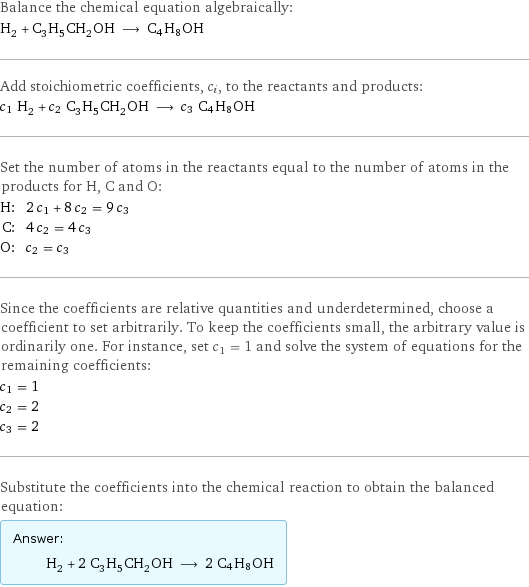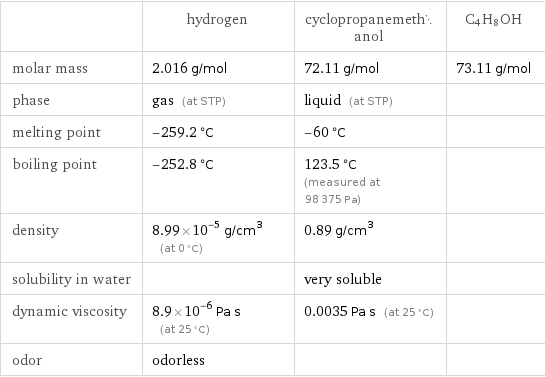Input interpretation

H_2 hydrogen + C_3H_5CH_2OH cyclopropanemethanol ⟶ C4H8OH
Balanced equation

Balance the chemical equation algebraically: H_2 + C_3H_5CH_2OH ⟶ C4H8OH Add stoichiometric coefficients, c_i, to the reactants and products: c_1 H_2 + c_2 C_3H_5CH_2OH ⟶ c_3 C4H8OH Set the number of atoms in the reactants equal to the number of atoms in the products for H, C and O: H: | 2 c_1 + 8 c_2 = 9 c_3 C: | 4 c_2 = 4 c_3 O: | c_2 = c_3 Since the coefficients are relative quantities and underdetermined, choose a coefficient to set arbitrarily. To keep the coefficients small, the arbitrary value is ordinarily one. For instance, set c_1 = 1 and solve the system of equations for the remaining coefficients: c_1 = 1 c_2 = 2 c_3 = 2 Substitute the coefficients into the chemical reaction to obtain the balanced equation: Answer: | | H_2 + 2 C_3H_5CH_2OH ⟶ 2 C4H8OH
Structures

+ ⟶ C4H8OH
Names

hydrogen + cyclopropanemethanol ⟶ C4H8OH
Equilibrium constant
![Construct the equilibrium constant, K, expression for: H_2 + C_3H_5CH_2OH ⟶ C4H8OH Plan: • Balance the chemical equation. • Determine the stoichiometric numbers. • Assemble the activity expression for each chemical species. • Use the activity expressions to build the equilibrium constant expression. Write the balanced chemical equation: H_2 + 2 C_3H_5CH_2OH ⟶ 2 C4H8OH Assign stoichiometric numbers, ν_i, using the stoichiometric coefficients, c_i, from the balanced chemical equation in the following manner: ν_i = -c_i for reactants and ν_i = c_i for products: chemical species | c_i | ν_i H_2 | 1 | -1 C_3H_5CH_2OH | 2 | -2 C4H8OH | 2 | 2 Assemble the activity expressions accounting for the state of matter and ν_i: chemical species | c_i | ν_i | activity expression H_2 | 1 | -1 | ([H2])^(-1) C_3H_5CH_2OH | 2 | -2 | ([C3H5CH2OH])^(-2) C4H8OH | 2 | 2 | ([C4H8OH])^2 The equilibrium constant symbol in the concentration basis is: K_c Mulitply the activity expressions to arrive at the K_c expression: Answer: | | K_c = ([H2])^(-1) ([C3H5CH2OH])^(-2) ([C4H8OH])^2 = ([C4H8OH])^2/([H2] ([C3H5CH2OH])^2)](../image_source/60989e172d199821231b403468a3d887.png)
Construct the equilibrium constant, K, expression for: H_2 + C_3H_5CH_2OH ⟶ C4H8OH Plan: • Balance the chemical equation. • Determine the stoichiometric numbers. • Assemble the activity expression for each chemical species. • Use the activity expressions to build the equilibrium constant expression. Write the balanced chemical equation: H_2 + 2 C_3H_5CH_2OH ⟶ 2 C4H8OH Assign stoichiometric numbers, ν_i, using the stoichiometric coefficients, c_i, from the balanced chemical equation in the following manner: ν_i = -c_i for reactants and ν_i = c_i for products: chemical species | c_i | ν_i H_2 | 1 | -1 C_3H_5CH_2OH | 2 | -2 C4H8OH | 2 | 2 Assemble the activity expressions accounting for the state of matter and ν_i: chemical species | c_i | ν_i | activity expression H_2 | 1 | -1 | ([H2])^(-1) C_3H_5CH_2OH | 2 | -2 | ([C3H5CH2OH])^(-2) C4H8OH | 2 | 2 | ([C4H8OH])^2 The equilibrium constant symbol in the concentration basis is: K_c Mulitply the activity expressions to arrive at the K_c expression: Answer: | | K_c = ([H2])^(-1) ([C3H5CH2OH])^(-2) ([C4H8OH])^2 = ([C4H8OH])^2/([H2] ([C3H5CH2OH])^2)
Rate of reaction
![Construct the rate of reaction expression for: H_2 + C_3H_5CH_2OH ⟶ C4H8OH Plan: • Balance the chemical equation. • Determine the stoichiometric numbers. • Assemble the rate term for each chemical species. • Write the rate of reaction expression. Write the balanced chemical equation: H_2 + 2 C_3H_5CH_2OH ⟶ 2 C4H8OH Assign stoichiometric numbers, ν_i, using the stoichiometric coefficients, c_i, from the balanced chemical equation in the following manner: ν_i = -c_i for reactants and ν_i = c_i for products: chemical species | c_i | ν_i H_2 | 1 | -1 C_3H_5CH_2OH | 2 | -2 C4H8OH | 2 | 2 The rate term for each chemical species, B_i, is 1/ν_i(Δ[B_i])/(Δt) where [B_i] is the amount concentration and t is time: chemical species | c_i | ν_i | rate term H_2 | 1 | -1 | -(Δ[H2])/(Δt) C_3H_5CH_2OH | 2 | -2 | -1/2 (Δ[C3H5CH2OH])/(Δt) C4H8OH | 2 | 2 | 1/2 (Δ[C4H8OH])/(Δt) (for infinitesimal rate of change, replace Δ with d) Set the rate terms equal to each other to arrive at the rate expression: Answer: | | rate = -(Δ[H2])/(Δt) = -1/2 (Δ[C3H5CH2OH])/(Δt) = 1/2 (Δ[C4H8OH])/(Δt) (assuming constant volume and no accumulation of intermediates or side products)](../image_source/1f4ebd769d9e11d0af860e88ba5e89d9.png)
Construct the rate of reaction expression for: H_2 + C_3H_5CH_2OH ⟶ C4H8OH Plan: • Balance the chemical equation. • Determine the stoichiometric numbers. • Assemble the rate term for each chemical species. • Write the rate of reaction expression. Write the balanced chemical equation: H_2 + 2 C_3H_5CH_2OH ⟶ 2 C4H8OH Assign stoichiometric numbers, ν_i, using the stoichiometric coefficients, c_i, from the balanced chemical equation in the following manner: ν_i = -c_i for reactants and ν_i = c_i for products: chemical species | c_i | ν_i H_2 | 1 | -1 C_3H_5CH_2OH | 2 | -2 C4H8OH | 2 | 2 The rate term for each chemical species, B_i, is 1/ν_i(Δ[B_i])/(Δt) where [B_i] is the amount concentration and t is time: chemical species | c_i | ν_i | rate term H_2 | 1 | -1 | -(Δ[H2])/(Δt) C_3H_5CH_2OH | 2 | -2 | -1/2 (Δ[C3H5CH2OH])/(Δt) C4H8OH | 2 | 2 | 1/2 (Δ[C4H8OH])/(Δt) (for infinitesimal rate of change, replace Δ with d) Set the rate terms equal to each other to arrive at the rate expression: Answer: | | rate = -(Δ[H2])/(Δt) = -1/2 (Δ[C3H5CH2OH])/(Δt) = 1/2 (Δ[C4H8OH])/(Δt) (assuming constant volume and no accumulation of intermediates or side products)
Chemical names and formulas

| hydrogen | cyclopropanemethanol | C4H8OH formula | H_2 | C_3H_5CH_2OH | C4H8OH Hill formula | H_2 | C_4H_8O | C4H9O name | hydrogen | cyclopropanemethanol | IUPAC name | molecular hydrogen | cyclopropylmethanol |
Substance properties

| hydrogen | cyclopropanemethanol | C4H8OH molar mass | 2.016 g/mol | 72.11 g/mol | 73.11 g/mol phase | gas (at STP) | liquid (at STP) | melting point | -259.2 °C | -60 °C | boiling point | -252.8 °C | 123.5 °C (measured at 98375 Pa) | density | 8.99×10^-5 g/cm^3 (at 0 °C) | 0.89 g/cm^3 | solubility in water | | very soluble | dynamic viscosity | 8.9×10^-6 Pa s (at 25 °C) | 0.0035 Pa s (at 25 °C) | odor | odorless | |
Units
